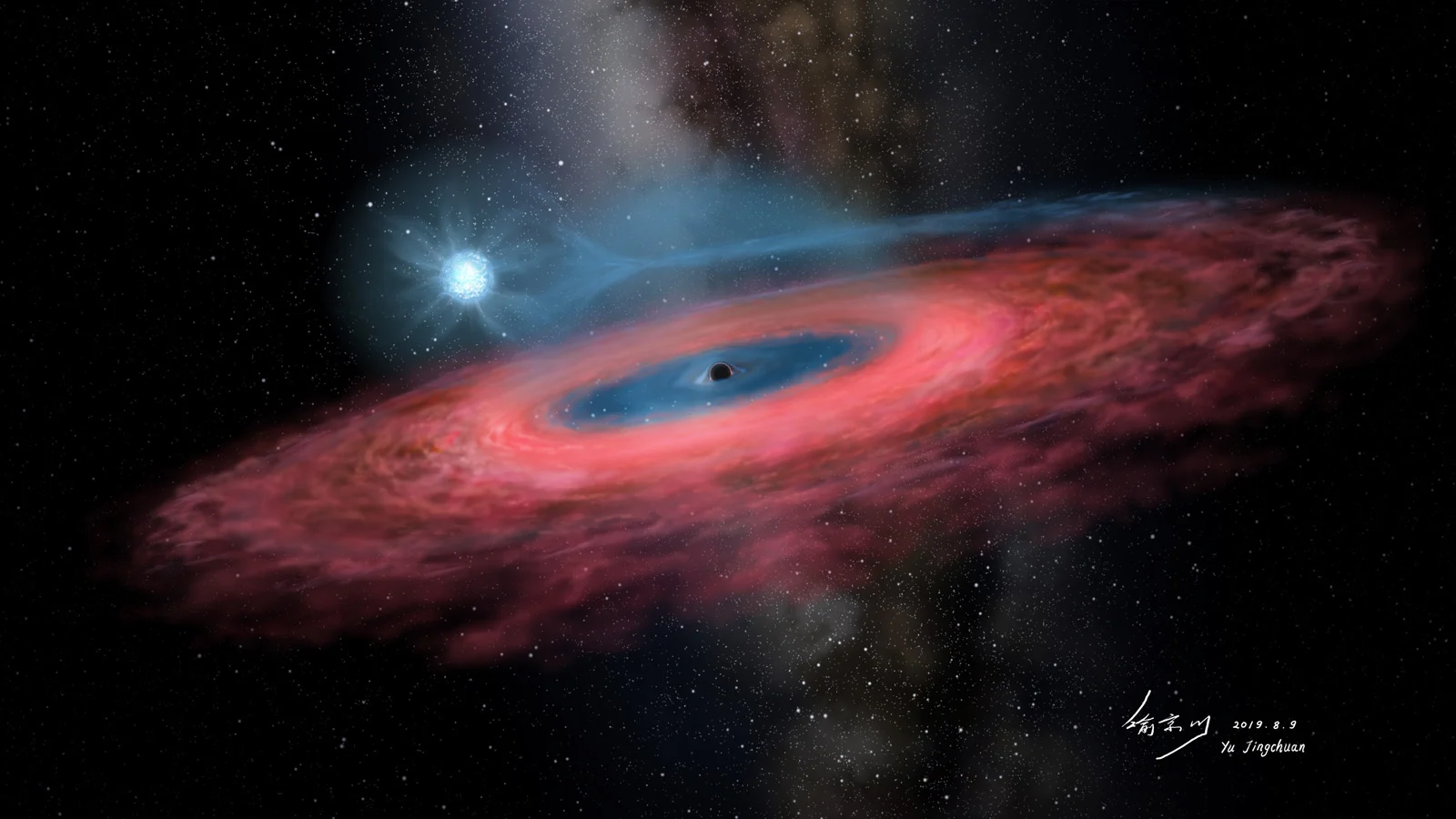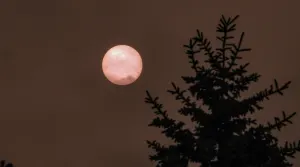
Black hole found in our galaxy is so massive it 'should not even exist'
This stellar black hole is a record-breaker in our Milky Way galaxy

An artist's impression of a massive black hole and the accretion disk it has gathered as its intense gravity pulls matter off of a blue companion star. Credit: YU Jingchuan, Beijing Planetarium
Last month, astronomers reported finding what could be the smallest stellar black hole ever discovered. Now, an international team may have found one that is so massive it actually breaks the scale!
When astronomers talk about black holes, they typically fall into one of two categories.
There are 'supermassive black holes', one of which is thought to reside in the core of every galaxy we can see, including our own Milky Way. These black holes truly live up to their name, as they can tip the scales at millions to tens of billions of times more massive than our Sun. While scientists have some ideas for how these black holes formed, there are no definitive answers yet.
The other type are 'stellar black holes', which form when a massive star - at least 20 times more massive than our Sun - reaches the end of its lifespan. In a cataclysmic explosion known as a supernova, it blows off its outer layers, leaving behind a 4-5 solar mass core, which collapses in on itself to form a black hole.

Artist's impression of a binary black hole. Credit: ESO/L. Calçada
The most massive stellar black hole found in our galaxy, up until now, tips the scales at just shy of 15 solar masses. Scientists put the upper limit of stellar black hole mass, theoretically, at around 30-40 solar masses.
Now, a team of astronomers led by scientists at the Chinese Academy of Sciences have published a new paper in the journal Nature reporting the discovery of LB-1 - what could be the most massive stellar black hole ever found in our galaxy.
"Black holes of such mass should not even exist in our galaxy, according to most of the current models of stellar evolution," said Professor Liu Jifeng of the National Astronomical Observatory of China, according to the Chinese Academy of Sciences.
LB-1 was discovered as Liu's team observed a large blue star, about 8 times more massive than the Sun and at a distance of around 14,000 light years, wobbling back and forth against the backdrop of space. Based on this wobble, they found the best explanation was that the star was orbiting some other object, once every 79 days. Since they couldn't seen what this star was orbiting, that pointed to the possibility of it being a quiet black hole - one that was not producing x-rays as it gobbled up matter from its accretion disk.
By their calculations, however this black hole was huge, weighing in at nearly 70 solar masses! Based on what we know of how massive stars form and die, a black hole that big shouldn't be possible in our galaxy.
According to Liu, the biggest stars in our Milky Way galaxy typically shed a great deal of their mass as they approach the end of their lifetime, due to having very powerful stellar winds. This is very similar to how our Sun sheds mass in a steady stream via the solar wind, but much stronger, carrying away far more mass in a much shorter time. Due to this process, they should not be capable of leaving behind a remnant that can collapse into a 70 solar mass black hole.
"LB-1 is twice as massive as what we thought possible," Liu explained. "Now theorists will have to take up the challenge of explaining its formation."
It should be noted that the results of this study are not yet conclusive. Before the researchers can confirm the 'oversized' mass of this black hole, they need to resolve an interesting inconsistency in what they are seeing.
Based on their observations and examining the spectrum of the black hole's companion, it appears to be a giant blue 'B-type' star. By comparing its brightness ('luminosity') with other known B-type stars, the researchers came up with their distance of 14,000 light years.

The problem with that, however, is the map of the Milky Way produced by the European Space Agency's Gaia mission doesn't agree. According to Gaia's measurements, the distance to the companion star is only half what the researchers calculated.
In astronomy, brightness, size and distance are all related to one another. Basically, at the same brightness, a more distant star will be more massive than a closer star. So, if Gaia's distance for the black hole's companion is right, that would mean its mass is significantly lower. Rather than a blue giant star, it would probably be a yellow-white star, only about 30 per cent more massive than our Sun. And since the mass of the black hole was computed by relating it to the mass of the companion star, its computed mass would drop from 70 solar masses, to only 10 solar masses.
The problem with just accepting Gaia's distance, and settling on the discovery of a new 10 solar mass black hole, is their observations of the star's spectral type just doesn't match a star with a mass of only 1.3 solar masses. So, either Gaia is wrong and this team has discovered the largest stellar black hole ever found in our galaxy, or Gaia is right and they've found a fairly normal black hole with a companion star that is acting very strangely.
The researchers do acknowledge that the companion star could be going through some kind of short-lived state that affects its brightness or spectrum. The star may have emitted a recent outburst, or perhaps it was affected by the supernova blast that produced the black hole. Given just how short-lived such a state would be, though, they find the chances of actually observing it unlikely.
So, what if they're right? What if Liu's team actually discovered a 70 solar mass stellar black hole? How could such a thing have formed in our galaxy?
For a single star to produce a 70 solar mass black hole, it would need to be upwards of 200 solar masses before it went supernova. There are some stars that big, but they are fairly rare.
One possibility is that this used to be a triple star system in the distant past, with two immense 60-solar-mass blue-white hypergiant stars circling each other in a close binary, with the 8-solar-mass blue giant orbiting both as a distant companion. When the two central stars died and went supernova, each would collapse into a 35-solar-mass black hole, and those two black holes would have eventually merged, long before we could detect the gravitational waves produced by such an event. Thus, it would have left behind the system we see today.
Either way, this is a fascinating discovery that may require astronomers and astrophysicists to re-write some of what we know about how black holes form.
"This remarkable result along with the LIGO-Virgo detections of binary black hole collisions during the past four years really points towards a renaissance in our understanding of black hole astrophysics," LIGO Director David Reitze, from the University of Florida, told the Chinese Academy of Sciences.
Source: Chinese Academy of Sciences
Author's note: After further reading into this discovery, more details have been added to the above story.










